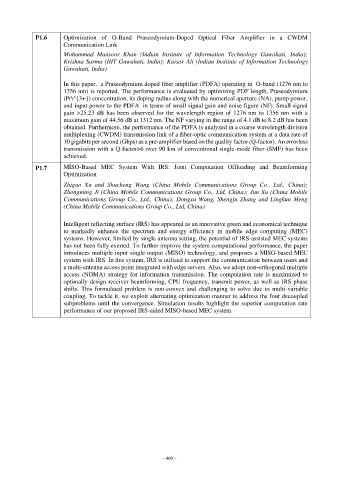Page 513 - Kaleidoscope Academic Conference Proceedings 2024
P. 513
P1.6 Optimization of O-Band Praseodymium-Doped Optical Fiber Amplifier in a CWDM
Communication Link
Mohammad Mansoor Khan (Indian Institute of Information Technology Guwahati, India);
Krishna Sarma (IIIT Guwahati, India); Kaisar Ali (Indian Institute of Information Technology
Guwahati, India)
In this paper, a Praseodymium doped fiber amplifier (PDFA) operating in O-band (1276 nm to
1356 nm) is reported. The performance is evaluated by optimizing PDF length, Praseodymium
(Pr\^{3+}) concentration, its doping radius along with the numerical aperture (NA), pump power,
and input power to the PDFA in terms of small signal gain and noise figure (NF). Small signal
gain >25.23 dB has been observed for the wavelength region of 1276 nm to 1356 nm with a
maximum gain of 44.56 dB at 1312 nm. The NF varying in the range of 4.1 dB to 8.2 dB has been
obtained. Furthermore, the performance of the PDFA is analyzed in a coarse wavelength division
multiplexing (CWDM) transmission link of a fiber-optic communication system at a data rate of
10 gigabits per second (Gbps) as a pre-amplifier based on the quality factor (Q-factor). An errorless
transmission with a Q-factor>6 over 90 km of conventional single-mode fiber (SMF) has been
achieved.
P1.7 MISO-Based MEC System With IRS: Joint Computation Offloading and Beamforming
Optimization
Zhiguo Xu and Shucheng Wang (China Mobile Communications Group Co., Ltd., China);
Zhongming Ji (China Mobile Communications Group Co., Ltd, China); Jun Xu (China Mobile
Communications Group Co., Ltd., China); Dongxu Wang, Shengju Zhang and Lingkun Meng
(China Mobile Communications Group Co., Ltd, China)
Intelligent reflecting surface (IRS) has appeared as an innovative green and economical technique
to markedly enhance the spectrum and energy efficiency in mobile edge computing (MEC)
systems. However, limited by single antenna setting, the potential of IRS-assisted MEC systems
has not been fully exerted. To further improve the system computational performance, the paper
introduces multiple-input single-output (MISO) technology, and proposes a MISO-based MEC
system with IRS. In this system, IRS is utilized to support the communication between users and
a multi-antenna access point integrated with edge servers. Also, we adopt non-orthogonal multiple
access (NOMA) strategy for information transmission. The computation rate is maximized to
optimally design receiver beamforming, CPU frequency, transmit power, as well as IRS phase
shifts. This formulated problem is non-convex and challenging to solve due to multi-variable
coupling. To tackle it, we exploit alternating optimization manner to address the four decoupled
subproblems until the convergence. Simulation results highlight the superior computation rate
performance of our proposed IRS-aided MISO-based MEC system.
– 469 –

